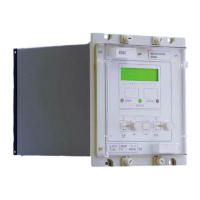Manual
KVCG202/EN M/H
Figure 10: Operation of 2 transformers connected in parallel on local busbars
The total load current is shared between the two transformers as the inverse ratio of
impedances and for similar transformers
I1 = I2 and IL = 2 I1 = 2 I2
There are several methods of controlling paralleled transformer groups and these may be
classified into two categories.
- those which use a single VRR to operate a group of tap changers
- those which have a VRR in operation for each individual transformer
4.7.1 Master-Follower schemes
Control schemes in category a) above are generally described as master-follower
schemes. A transformer whose VRR is operative is designated as a ‘master’ or ‘leader’
and the remaining transformers in the group are designated ‘followers’ or ‘trailers’.
Where the VRR initiates a tap change then the ‘master’ transformer operates and the
‘followers’ are operated to occupy the same service position as the master transformer.
For multiple tap change sequences it is necessary to operate a paralleled transformer
group step by step i.e. all transformers must occupy the same tap step before the master
transformer can perform a second tap change step in a multiple tap step sequence.
There are a number of circuit arrangements for coupling such schemes. One method is to
have a potentiometer mechanically coupled to each tap changer so that the position of
the moving element corresponds to the selected tap position. The common points of
each potentiometer are then interconnected through coupling relays, which operate to
correct any tapping disparity with reference to the master transformer. Alternatively, a
step by step sequence can be controlled by interconnecting step switches from each tap
changer in such a way that the ‘followers’ sequentially come into alignment with the
‘master’ transformer without using coupling relays.
A simple master-follower scheme could be arranged with a KVGC relay on each parallel
transformer. The master VRR is set to AUTO mode and the followers set to MANUAL
mode. The master relay is set regulate the busbar voltage and operate the local tap
changer in the standard way with two of it’s output contacts arranged to give raise and
lower commands. The followers are controlled from two more contacts on the master
VRR set to give raise and lower commands to the manual raise and lower opto inputs on
the follower relays. In this way when the master relay issues a raise or lower command
the follower relays will give a raise or lower commands via their manual tap change
controls. If the KVGC is configured to use it’s tap position indication then two output
contacts can be arranged to indicate even and odd tap positions. These contacts can be
wired externally to give an out of step alarm after a time delay if all the transformers are
not in step i.e. not all at odd or even tap positions. The circulating current alarm could
also be used to indicate an out of step condition for more then one tap position apart if
pilot connections are used to extract the circulating current.

